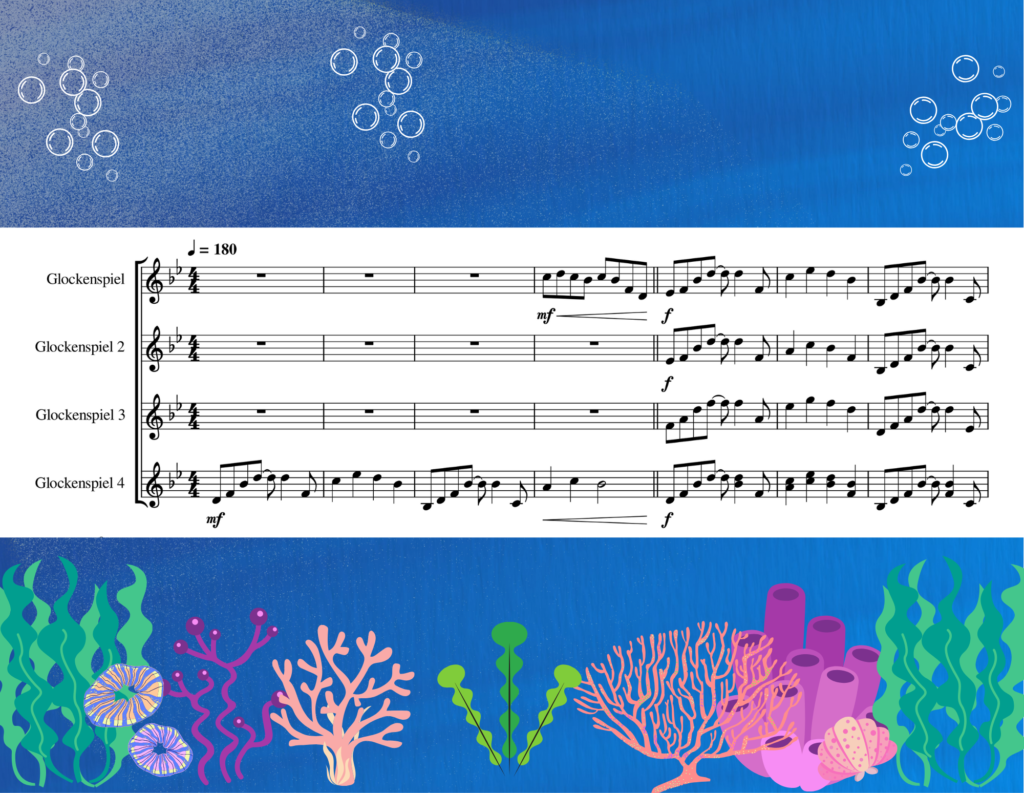
Many parents and music teachers see the xylophone as a beginner’s instrument—perfect for nursery rhymes but not much else. This belief can limit a child’s musical journey before it even begins. But what if the xylophone could do more? In this article, we introduce Under the Sea—a vibrant piece for four xylophones and percussion ensemble—that proves the xylophone is more than just a toy. If you’re a music educator or a parent looking to expand your child’s musical horizons, this is for you!
Key notes
- Ensemble playing helps kids develop coordination, listening skills, and teamwork.
- Under the Sea proves that xylophones can play complex, layered music—not just simple melodies.
- The four xylophone parts work together:
- Xylophone 1: Melody
- Xylophone 2: Harmony support
- Xylophone 3: Bridge between melody & bass
- Xylophone 4: Bassline foundation
- Percussion elements add texture and energy to the piece.
- Pre-rehearsal exercises (steady beat, call & response, chord building, layered entry) improve harmony and timing.
- Breaking the xylophone stereotype: It’s not just a beginner’s instrument—it’s a powerful ensemble tool!
- Download the part and the percussion tracks here!
Moreover, the WordPress community and theme developers are actively contributing to a growing library of block patterns, making it easier for users to find a pattern that suits their needs. Whether you’re building a landing page, a photo gallery, or a complex layout, there’s likely a block pattern ready to use.
This democratizes design for non-technical users while offering developers a way to extend WordPress functionality and provide more options to their clients.
The Magic of Ensemble Playing
Playing music in an ensemble is a transformative experience for young musicians. It teaches coordination, active listening, and teamwork skills far beyond the music classroom. When children play together, they learn to balance their sound within a group, keep a steady tempo, and respond to the musical cues of others.

With Under the Sea, students experience firsthand how their individual parts contribute to a larger, more exciting musical piece. This piece is designed to be both accessible and engaging, proving that even a simple xylophone can create a rich, layered sound when played in harmony with others.
Understanding the Xylophone Parts
In this arrangement, the four xylophones work together to create a full, balanced sound:
- Xylophone 1: Plays the main melody, carrying the recognizable theme of Under the Sea.
- Xylophone 2: Provides harmonic support, reinforcing the melody with chords.
- Xylophone 3: Adds rhythmic and harmonic depth, bridging the melody and the bassline.
- Xylophone 4: Plays the bassline, anchoring the harmony and driving the rhythm.
Percussion instruments such as a shaker, tambourine, and a small drum add extra texture, making the piece even more dynamic and engaging.
Exercises to Work on Harmony and Tempo
Before jumping into the full piece, it’s helpful to break it down into smaller exercises:
- Steady Beat Exercise: Have students clap or tap their mallets in time with a metronome at the song’s tempo (start slow, then gradually speed up). This builds a strong internal sense of rhythm.
- Call and Response: The teacher or one student plays a short rhythmic pattern, and the group repeats it. This strengthens listening skills and ensemble coordination.
- Chord Building: Each xylophone plays one note of a chord (e.g., C-E-G for a C major chord), striking together to hear how their parts fit into the harmony.
- Layered Entry Practice: Start with Xylophone 4 playing alone, then add Xylophone 3, followed by Xylophone 2, and finally Xylophone 1. This helps students hear how their parts blend together.
By mastering these exercises, students will gain confidence and ease when playing the full piece, ensuring a polished and exciting performance.
